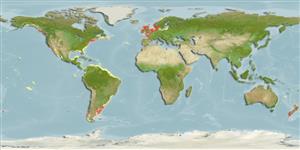Common names from other countries
Classification / Names / Names
Nombres comunes | Sinónimos | Catalog of Fishes (gen., sp.) | ITIS | CoL | WoRMS
Environment: milieu / climate zone / depth range / distribution range
Ecología
; rango de profundidad 0 - 55 m (Ref. 83939). Subtropical
Atlantic Ocean, Pacific Ocean and the Mediterranean.
Length at first maturity / Tamaño / Peso / Age
Maturity: Lm ? range ? - ? cm Max length : 10.0 cm TL macho / no sexado; (Ref. 402)
This is a benthic species found on rocky bottoms particularly in intertidal and subtidal areas (Ref. 83938). It is a burrowing and encrusting species inhabiting hard substrates like rocks, empty mollusk shells, Caryophyllia and Lithothamnion (Ref. 402).
Life cycle and mating behavior
Madurez | Reproducción | Puesta | Huevos | Fecundidad | Larva
Members of the phylum Phoronida are mostly hermaphroditic. Life cycle: Embryos develop into free-swimming planktotrophic actinotrocha larvae which later sinks to the bottom and metamorphose into benthic adults.
Hansson, H.G. 1999. (Ref. 997)
IUCN Red List Status (Ref. 130435)
CITES status (Ref. 108899)
Not Evaluated
Not Evaluated
Human uses
| FishSource |
Herramientas
Más información
Age/Size
Crecimiento
Length-weight
Length-length
Morfología
Larva
Abundancia
Fuentes de Internet
Estimates based on models
Preferred temperature
(Ref.
115969): 8.6 - 15.8, mean 10.7 (based on 560 cells).
Price category
Unknown.
